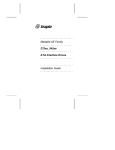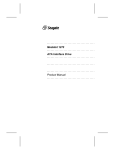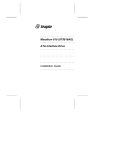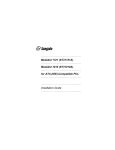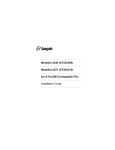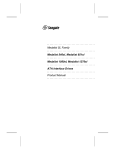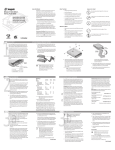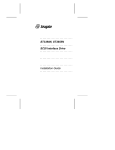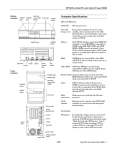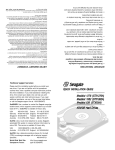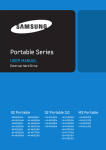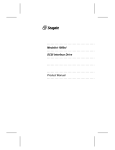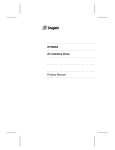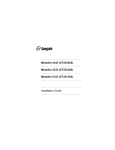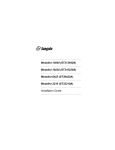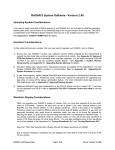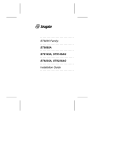Download Seagate MEDALIST 545XE Installation guide
Transcript
INSTALLING Y OUR NEW S EAGATE HARD DRIVE MEDALIST HARD DRIVE INSTALLATION GUIDE Medalist 545xe (ST3660A) Medalist 630xe (ST3630A) for ATA (IDE)-Compatible PCs Thank you for selecting a Seagate hard drive. Installing your new Seagate hard drive is easy when you use this easy drive-installation sheet. For technical information and troubleshooting tips, see the back of this sheet. If you have additional questions, call your computer dealer or contact Seagate technical support. This symbol indicates additional information on the back of this sheet. B EFORE Y OU B EGIN Important. Do not format this drive without first reading the instructions and removing the free drive-support software that is stored on the drive. 1. ONE DRIVE OR TWO? 1 Your Seagate drive is factory-configured to operate as a single drive or as the master drive with an ATAcompatible slave. To make the drive the slave, place a jumper on pins 7 and 8 of the options jumper block shown below. The options jumper block also lets you configure the drive to work with computers that use cable-select interconnection and provides options you can try if the computer does not recognize the slave after startup. These options are shown in the drawing and are discussed on the back of this poster. • Make sure your computer is turned off before you open the case. • Read the handling precautions at the right and inspect the drive to make sure that it is not damaged. • Save your foam-lined Seagate disc drive box. This box has been approved by Seagate for shipping a Seagate disc drive. Using any other container or packing material voids your drive warranty. A CCESSING MORE THAN 528 M BYTES HANDLE WITH C ARE! Disc drives are extremely fragile. Do not drop or jar your drive. Keep the drive in its antistatic bag until you are ready to install it. Protect your drive from static discharge by making sure you are well grounded before touching the drive. We recommend wearing a grounded wrist strap throughout the installation process. Do not touch the connectors or any part of the printed circuit board. • Straight-edge and Phillips screwdrivers • Drive mounting screws • If you are mounting this 3.5-inch drive in a 5.25-inch drive bay, you need a mounting adapter or frame kit. • You may need drive mounting rails if your drive bay is not designed for direct mounting. • A drive host adapter and connector cable with enough connectors for all your drives • An unused drive power cable to plug into your new drive • A bootable DOS system diskette (Seagate recommends using DOS Version 5.0 or later.) • A blank 1.2-Mbyte or 1.4-Mbyte diskette for transferring the drive-support software to after you have mounted the drive Always handle the drive by its edges or frame. Do not apply pressure or attach labels to the circuit board or the top of the drive. A TTACHING C ABLES The full capacity of your drive exceeds the maximum capacity many older computers can address. If your computer’s BIOS was manufactured before June of 1994, it may not be able to access more than 528 Mbytes. Several options are available for surpassing the 528-Mbyte barrier. We recommend the following: WHAT Y OU WILL NEED 1 Attach one end of the 40-pin drive interface cable to the interface connector on your computer or host adapter as shown below. After threading the cable through the drive bay, attach your drive or drives to one of the connectors on the interface cable. Caution. Make sure to align pin 1 of the computer’s interface connector or the host adapter with pin 1 of your drive or drives. 1 Use a hard drive controller or a BIOS upgrade that supports drives with capacities greater than 528 Mbytes, or MOUNTING THE DRIVE You can mount the drive in any orientation. Secure the drive with four 6-32 UNC-2A mounting screws not more than six full turns into the drive frame in either the side mounting holes or the bottom mounting holes. Do not overtighten. Do not use metric screws. After mounting the drive, replace the computer cover. If you are mounting the drive in a 5.25-inch drive bay, you need a mounting adapter or frame kit. Contact your computer dealer. Some computers may also require drive mounting rails, which can be obtained from your distributor or computer manufacturer. 2 Use the free Disk Manager software stored on your Seagate drive to install the drive. Caution. You must transfer the replacement 32-bit disk access driver for Windows 3.1, the free Disk Manager software and the other software stored on the drive to a diskette in Drive A before you partition and format the drive. Instructions for transferring the software are provided in Section 2, “Transferring the Free Seagate Software.” 2. TRANSFERRING THE FREE S EAGATE S OFTWARE 2 The factory stores free software files on the drive that 1) allow your computer to access the drive’s full capacity when the 528-Mbyte barrier is imposed; 2) you can use to partition and format the drive; and 3) provide information on other Seagate products. Transfer these files to a blank, bootable diskette in Drive A before you partition and format the drive. You need two diskettes if you want all of the files. The software programs are: SEG32BIT.386. A replacement 32-bit disk access driver for Windows 3.1 that provides full support for drives with capacities greater than 528 Mbytes in Windows. Disk Manager. Installation software that partitions and formats your drive and installs a software driver to surpass the 528-Mbyte barrier if necessary. DRVINF11. A program that reads an installed ATA drive and displays the drive’s major features. Seamove. Transfers the above software programs to a diskette in Drive A and erases the factory partition and format after the files are transferred. STDR9511.EXE. The Seagate Technical Desk Reference is a Windows application that contains information on other Seagate products. You must copy this file to a separate diskette using the standard copy command before you use Seamove to transfer the other files. a 3. CONFIGURING S ETUP To make a bootable diskette and transfer the files: 1 Turn your computer on and enter Setup. See your computer or motherboard reference manual for instructions on how to enter Setup. It may be called System Setup, BIOS Setup or CMOS Setup. 2 Locate the hard disc configuration settings. 3 Select user-defined or custom, and configure the drive for 615 cylinders, 4 heads and 17 sectors (Drive-type 2). Save and exit Setup. 4 Immediately insert your DOS diskette into Drive A. 5 At the A prompt, type format a: /s and press ENTER. The /s switch makes the new diskette bootable. 6 The computer reads the DOS diskette and prompts you to insert a blank diskette into Drive A when it is ready to format the new diskette. 7 When the format is complete, reboot the computer with the new diskette. 8 Access the prompt assigned for your new Seagate drive. 9 Type seamove. Seamove transfers the files from the drive to your diskette. It erases the partition and the files when the transfer is complete. We refer to this diskette as the Seagate software diskette. 4A. INSTALLATION WITH DISK MANAGER S OFTWARE 4 1 Boot your computer with the Seagate software diskette. This is a precaution to ensure that the Disk Manager installation does not conflict with any terminate-and-stay resident programs that may load into memory. 2 At the DOS prompt, type dm and press ENTER. 3 Follow the screen instructions until the Select an Install Option dialog box appears. Select (E)asy Disk Installation and press ENTER. This puts a single partition and a quick format on the drive. 4 Verify that the drive model number appears on the screen. If you have two drives, both model numbers must appear. Select the drive you want to install and press ENTER. Disk Manager partitions and formats the drive and makes it bootable if it is Drive C. If the model number is not shown, exit Disk Manager and turn off the computer. Check all cables and jumper settings. Try again. 5 Follow the instructions in the post-installation screens. 2 Attach a power cable to each drive as shown. 3 You must configure the computer to recognize the full capacity of your drive. If your BIOS cannot access the full capacity of the drive and you choose to use Disk Manager, you can leave the hard drive parameters you used for transferring the software file in Setup. Go to Section 4A “Installation with Disk Manager Software.” Disk Manager will install its software driver, Dynamic Drive Overlay (DDO), to make the drive’s full capacity available. If your BIOS can accept more than 528 Mbytes, use the steps below to configure the BIOS. Many BIOSs use logical block addressing (LBA) mode to access drives with capacities greater than 528 Mbytes. Check your documentation for this feature. 1 Turn your computer on and enter Setup. 2 Enable LBA mode if it is available. 3 Locate the hard disc configuration settings. 4 If your Setup has an Auto option, select it. Save and exit Setup. The computer automatically determines the drive parameters and configures Setup. If there is no Auto option and LBA mode is enabled, select user-defined or custom, and enter the LBA parameters shown for your drive in the table. If Setup does not accept all of the LBA parameters, use the CHS (cylinder, head and sector) parameters. If there is no Auto option and no LBA mode, select user-defined or custom and enter the CHS parameters. Drive Model ST3660A Mode CHS Cylinders 1,057 Heads 16 Sectors per track 63 ST3630A CHS 1,223 16 63 ST3660A LBA 528 32 63 ST3630A LBA 611 32 63 Note. Your drive does not use write precomp or landing zone parameters; set these parameters to zero. 5 Save the settings and exit Setup. Your computer will continue the startup sequence. After the BIOS is configured, you can use either Disk Manager to partition and format the drive (see Section 4A “Installation with Disk Manager Software”) or the standard partition and format (see Section 4B “Standard Partitioning and Formatting”). 4B. STANDARD P ARTITIONING AND FORMATTING If the BIOS cannot accept your drive’s geometry, Disk Manager installs a software driver, Dynamic Drive Overlay (DDO), that allows the computer to access your drive’s fullcapacity.Read the Important Information—Please Read screen carefully; it tells you how to boot with a diskette when your drive requires the Disk Manager software driver. If your computer requires DDO to access your new Seagate drive, the Disk Manager banner must appear when you boot the computer after installing the drive. If the banner does not appear, the computer will not recognize the drive. Make sure that Drive A is empty when you boot. Try again. Y OU’RE DONE! b 4 Caution. Partitioning or formatting a drive erases all of the data on it. Seagate assumes no liability if you erase your data. Before you partition or format the drive, be sure to transfer the free software files stored on the drive at the factory. Drive Partitioning 1 Insert a bootable DOS diskette in Drive A and boot your computer. 2 At the A: prompt, type fdisk and press ENTER. Note. If you have two drives installed, the menu displays five options. Option five allows you to select the drive you want to partition. Make sure you select the correct drive. 3 Type 1 for “Create DOS partition or logical DOS drive” and press ENTER. 4 Type 1 and press ENTER to “Create primary DOS partition.” Type yes and press ENTER. This puts the entire drive on one partition and makes the partition active. When the partitioning is complete, FDISK reboots your computer. Drive Formatting At the A: prompt, type format d: /s, where d is the letter of your new hard drive (DOS automatically assigns a letter for each partition you create). Caution. Make sure that you use the correct drive letter. All data on the drive is erased during the format. When the formatting completes, your drive is ready. Y OU’RE DONE! WINDOWS 32-BIT DISK A CCESS The 32-bit disk access feature in Windows 3.1 does not work with drives that have capacities greater than 528 Mbytes. If you want to use this feature, install the Seagate replacement 32-bit access driver, SEG32BIT.386, located on your Seagate software diskette. If during installation Windows 3.1 activates the 32-bit disk access feature in your system, a message suggesting that you disable 32-bit disk access appears the first time Windows loads into memory. Choose to disable 32bit disk access to open Windows. 3 Select Operating System Installation. 4 Select the operating system you want to install. You can also open the online manual from the command line. Type dm/h and press ENTER. Press ENTER again to open the online table of contents menu. 2 Open the Windows Program Manager menu and select File. 3 Select Run. 4 In the command line box, type a: \stsetup.exe. 5 Read the license agreement that appears on the screen. If you agree to the terms, select Accept Agreement to continue. 6 The next screen lists the features the SEG32BIT.386 driver supports. If your computer supports these features, they will be active in 32-bit disk access mode with SEG32BIT.386 for all drives that support them. Select Install Driver to continue. To make the feature active, you must enable the 32-bit disk access option in the Windows control panel. Open the Control Panel. Select 386 Enhanced. Select Virtual Memory. Select Change>>. Select Use 32-Bit Disk Access (an X in the box enables the feature). Save the change. A DDITIONAL INSTALLATION OPTIONS The options jumper block is used to configure your Seagate drive to work with other drives on the controller. It allows you to configure the drive for systems that use cable-select interconnection and provides options you can try if your computer does not recognize the slave after startup. Systems Using Cable Select Some computers differentiate between master and slave drives using specially designed interface cables that have the line to pin 28 (the Cable Select pin) removed or cut at one end. The connector that has pin 28 disabled is used for the slave drive. See your computer manual to determine whether your computer supports this feature. To configure your Seagate drive for cable select, place a jumper on pins 3 and 4. Non-ATA-Compatible Slave This setting allows the drive to acknowledge some slave drives that do not conform to the ATA standard during startup. If the computer does not recognize the slave after startup, using this setting may help. PDIAG This setting allows the drive to acknowledge slaves that use the postdiagnostic signal that indicate the slave is ready for operation differently. A DVANCED DISK MANAGER OPTIONS General Disk Manager partitions and formats your drive. It installs the Dynamic Drive Overlay (DDO) software driver to provide access to the drive’s full capacity if your computer’s BIOS is not configured to access more than 528 Mbytes. DDO bypasses the BIOS during the boot sequence and loads the drive information before DOS is loaded. Disk Manager: • Provides an easy installation option that partitions and formats the new drive in seconds. • Provides an easy-to-use format if you want to customize your drive installation. • Installs a software driver, Dynamic Drive Overlay, that allows the Note. If your are installing OS/2 or Windows NT, we suggest that you print the instructions before you start the installation. To use DDO with OS/2 and Windows NT V3.5, you must replace up to four of the original files with files supplied by Disk Manager. The replacement files are located in the OS2 and the NT subdirectories on your Seagate software diskette. The online manual tells you which files you need to replace and under what conditions to replace them. If you need assistance renaming a file, refer to your DOS reference manual. If you need to make a copy of an install diskette, follow the instructions below—the installation diskette will not install if you use the standard copy command to copy it. 1 Insert the original diskette into Drive A and access the drive. 2 Type diskcopy a: a:. The computer will read the original diskette and prompt you to insert the destination diskette into Drive A. 3 Insert a blank diskette into Drive A and press any key. Erase the files you need to replace on the copy diskette, and copy the replacement files using the standard copy command. (If only one diskette drive is available for copying, first copy the required files to the hard drive from the appropriate subdirectory, then copy the files to your new diskette.) Removing the Dynamic Drive Overlay If Disk Manager installs your drive with DDO, you can, in many cases, remove DDO without losing your data. However, you will lose access to the full capacity of your drive unless you use another method that supports more than 528 Mbytes (see “Accessing More Than 528 Mbytes” on the front side). Three steps are required to remove DDO safely: 1) migrating the data, 2) configuring Setup with the drives’s translation and 3) uninstalling DDO. Follow the instructions below to remove DDO safely. • Copies the system files onto the new Drive C to make it bootable • Enables read/write multiple, a feature that increases performance by allowing multiple blocks of data to be transferred in a single burst if your computer also supports this feature. • Provides full drive-capacity support for several operating systems. • Provides complete, easy-to-use online documentation. Booting with a Diskette If Disk Manager installs DDO to access the full capacity of your drive, the information DDO uses to access the drive must load into memory before the operating system loads into memory. This occurs automatically when you boot to Drive C. To gain access to the drive when booting to Drive A: 1 Boot the computer with the Drive A door open. 2 When the Disk Manager banner appears, immediately press the SPACEBAR (you have about 2 seconds). 3 Insert the boot diskette and press the SPACEBAR. If you boot with a diskette regularly, you can create a Dynamic Drive Overlay boot diskette. It loads DDO into memory before loading the operating system. See the online manual for information on how to create a Dynamic Drive Overlay boot diskette. Supported Operating Systems Dynamic Drive Overlay provides full drive-capacity support for the following operating systems: MS-DOS Windows 3.x Windows NT 3.51 Window NT 3.50 (requires DM upgrade drivers) Windows 95 OS/2 V3.0 (Warp full pack) OS/2 V2.0–3.0 (requires DM upgrade drivers) Caution. Before you attempt to remove DDO, back up your data files. You may need to use the backup files to restore your disc if your data is lost. If the migration encounters a media defect or is interrupted by a power loss or hardware failure, the migration will fail and your data will be lost. Run CHKDSK, SCANDISK or a third-party equivalent to detect and repair any media defects before you attempt the migration. 1 Boot the computer to Drive C. 2 Put your Seagate software diskette into Drive A and access the A prompt. 3 Type dm and go to the Select Installation Options menu. 4 Select (M)aintenance Menu. 5 Select (M)igrate Dynamic Drive. This program shifts the data to where the standard format can find it. The migration may take up to an hour to complete, depending on the size of your drive. 6 When the Migration is complete, exit Disk Manager. 7 Remove the diskette, reboot the computer and enter Setup. 8 Configure the hard drive with the parameters shown for your drive in the translation geometry table in Section 3, “Configuring Setup,” on the front side of this poster. Save your changes and exit Setup. 9 When the boot is complete, insert the diskette and access the drive. 10 Type dm and go to the Maintenance Menu. 11 Select Uninstall (D)isk Manager. 12 Select the correct drive to uninstall. When the uninstall is complete, exit Disk Manager and reboot. 1 Go to the Select an Installation Option menu. 2 Select (V)iew/Print Online Manual. One solution is to slow the processor speed during startup. If your computer has a turbo switch, set it to slow speed before turning the computer on. If there is no turbo switch, you may be able to use keyboard commands; see your computer manual for details. After the computer is up and running, return the processor to the fast speed. Another solution is to warm-boot your computer after every power-on. • Check for I/O address conflicts. To isolate the conflict, verify that the drive and host adapter are compatible with your computer by removing all the peripheral adapter cards (power must be off) except for the video card. Reinstall the drive and host adapter card and boot the computer. If this is successful, reinstall the other peripherals one at a time until the conflict occurs. After you have isolated the source of the address conflict, you can resolve the conflict by changing the I/O address of the peripheral that appears to cause the conflict. • If you are booting from a diskette and Disk Manager installed your drive using DDO, the information in the boot record for the drive was not loaded. Make sure there is not a diskette in Drive A and reboot. If you want to boot with the diskette, follow the “Booting with a Diskette” instructions in column one. The dealer partitioned and formatted the drive for you in the store, but the drive does not respond when you install it. • Reboot the computer and make sure the drive spins up. Check all cables. • Make sure the power supply has adequate power for your system. • Make sure the DOS version the dealer used to partition and format the drive is the same version you have installed on your computer. If it isn’t, see your dealer. If you need assistance installing your drive, consult your dealer. Your dealer is familiar with system configurations and can help you with system conflicts and other technical issues. If you need additional assistance with your Seagate drive or other Seagate products, you can call SeaBOARD®, SeaFAX®, Seagate Technical Support FAX, SeaFONE® and SeaTDD™ services. Seagate technical support is also available on CompuServe and through the Internet. SeaBOARD Using a modem, you can access documentation, drive specifications and jumper settings for Seagate’s entire product line. You can also download software for installing and analyzing your drive. SeaBOARD is available 24 hours daily. It supports communications up to 9,600 baud. Set your communications software to eight data bits, no parity and one stop bit (8-N-1). SeaBOARD phone numbers are listed in the following table. Location Modem number United States England France Germany Singapore Thailand Australia Korea 408-438-8771 44-1-62-847-8011 (+33 1) 48 25 35 95 49-89-140-9331 65-292-6973 662-531-8111 61-2-756-2359 82-2-556-7294 SeaFAX You can use a touch-tone telephone to access Seagate’s automated FAX system to receive technical support information by return FAX. This service is available 24 hours daily. Location Telephone number United States England 408-438-2620 44-1-62-847-7080 This symbol provides the SeaFAX document number for the product or products being discussed where it appears. • Verify the Setup drive-type values. You must install the drive • Check for I/O address conflicts between peripheral cards. • Check for viruses. The screen remains blank when you power up the system. • Make sure the monitor is plugged in and turned on. • Check all cards. • Make sure the video card is seated in its slot and secured with mounting screws. • While the computer is powered down, remove the drive host adapter. If the screen turns on after you reboot, the host adapter may be incompatible or defective. If so, see your dealer. The system hangs in FDISK or fails to create or save the partition record. • Check all cables. • The DOS utilities diskette may be corrupted. Try your backup DOS diskette. • Make the partitions smaller. • Change the interrupt jumper setting on the host adapter. • Check for media defects at the beginning of the drive. Use CHKDSK, SCANDISK or a third-party surface scan utility. • Some BIOSs have a Track 0 protection feature that protects Track 0 from viruses. This can cause FDISK to hang the system. You must disable this feature in Setup before you can use FDISK. See your computer reference guide for assistance. Be sure to re-enable this important feature when FDISK is done. The system error message, “Drive not Ready,” appears. • Check all cable connections. Make sure that pin 1 of the drive is GENERAL TROUBLESHOOTING Basic Troubleshooting Techniques Warning. Always turn off the computer before changing jumpers or unplugging cables and cards. Wear a ground strap or take other antistatic precautions while handling your drive. Seagate Technical Support FAX 408/438-8137 You can FAX questions or comments to technical support specialists 24 hours daily. Responses are sent between 8:00 A.M. and 5:00 P.M. (Pacific time) Monday through Friday. SeaFONE 408/438-8222 You can talk to a technical support specialist between 8:00 A.M. and 5:00 P.M. (Pacific time) Monday through Friday. SeaFONE provides recorded technical information on selected Seagate products while you are on hold. You can access the recordings 24 hours daily. Before calling, note your system configuration and drive model number (STxxxx). SeaTDD 408/438-5382 Using a telecommunications device for the deaf (TDD), you can send questions or comments 24 hours daily and exchange messages with a technical support specialist between 8:00 A.M. and 5:00 P.M. (Pacific time) Monday through Friday. SeaBOARD CompuServe Forum Online technical support for Seagate products is available on CompuServe. To access our technical support forum, type go seagate. This forum provides information similar to that found on SeaBOARD. Seagate’s Internet Connections Technical information for Seagate drives is available on the internet from Seagate's World Wide Web home page (http://www.seagate.com) or Seagate's ftp server (ftp://ftp.seagate.com). The ftp server contains information similar to that found on SeaBOARD. connected to pin 1 of the hard disc controller or host adapter. • Make sure the power supply is adequate for system needs. • Reboot the computer and make sure the drive spins up. The FDISK error message, “No Fixed Disk Present,” appears. • Make sure the power supply is adequate for your system. • Verify the Setup drive-type values. • Check for I/O address conflicts. S TORING AND S HIPPING Y OUR DRIVE Keep your original box and packing materials for storing or shipping your drive. The box has a Seagate Approved Package label. Shipping a drive in an unapproved container voids the warranty. Call your authorized Seagate distributor to purchase additional boxes. The following figure shows how a drive fits in an approved single-pack box, including the packing materials. The drive does not format to full capacity. If you have installed your drive and it does not function properly, perform the following basic checks: • Verify compatibility. Verify that the host adapter and the drive are appropriately matched to each other and to your computer. Refer to relevant documentation for details. • Check all cards. Verify that all cards are seated in their slots on the motherboard and are secured with mounting screws. • Check all cables. Make sure all ribbon and power cables are securely connected. Ribbon cables are easily damaged, especially at the connector. Try a new cable or a known good cable. Make sure no socket pins were bent when the cable was inserted. For each cable, verify that pin 1 on the cable is aligned with pin 1 on the drive and host adapter. The edge-stripe on the ribbon cable is used to denote pin 1. • Verify the drive-type values in Setup. One of the following problems may have occurred: – The values may be set with an incorrect translation characteristic. – You may have entered a parameter value that exceeds the physical capacity of the drive. – You entered a translation characteristic that does not take full advantage of the drive’s capacity. – The drive’s physical specifications exceed the translation limits imposed by the BIOS. Note. If you reset the Setup drive-type values, you must partition and format the drive again. • If you have partitioned the drive into individual logical drives, you may Caution. Do not reverse-plug the power connector. This can damage your drive. • Verify equipment configuration. Review the instructions in this guide and the host adapter installation guide, and make sure that all appropriate jumpers are installed, or removed, to suit your application. • Check the power-supply specifications. If new devices are installed, your computer’s power supply may not support the new total power requirement. Consult your dealer. • Verify the drive-type settings in Setup. The drive-type settings in Setup must not exceed the physical specifications of your drive. Also, the settings must not exceed the limitations set by the operating system and BIOS. • Check for viruses. Before you use someone else’s diskette in your system for the first time, scan the diskette for viruses. Advanced Troubleshooting If you are installing an operating system other than DOS, you must first install your drive with DDO and make sure that it is bootable before you install the other operating system. Installation instructions for other operating systems are available in the online manual. To open the online manual: • Verify that each drive has a drive-type value in Setup. • Try rebooting your computer by pressing the CTRL, ALT, and DELETE keys S EAGATE T ECHNICAL S UPPORT S ERVICES using the same drive-type values your dealer used to partition the drive. computer to access the full capacity of your Seagate drive when the BIOS limits the drive capacity to 528 Mbytes. • Modifies the boot record with geometry for the new drive if the Dynamic Drive Overlay driver is required. very quiet, it may be difficult to hear its discs reach operating speed. Recheck all drive cables if the drive is not running. simultaneously. If the drive is recognized after the warm boot, the computer BIOS setup test may be completing before the drive is ready. To install the Seagate 32-bit disk access replacement driver: 1 Place your Seagate software diskette into Drive A. • Reboot the computer and make sure the drive motor runs. If the drive is If you have performed the preceding basic checks but the problem persists, follow these guidelines for troubleshooting specific cases: The system does not recognize the drive. • Check all cables. • Make sure the power supply is adequate for system needs. need to make the partitions smaller so that the computer can use all of the drive’s capacity. • If your computer supports LBA mode, you may need to enable the LBA mode function in Setup to get the drive’s full capacity. Refer to your computer’s reference guide. Warranty. See your authorized Seagate distributor or dealer. With regards to the Disk Manager and SEG32BIT.386 software, there are no warranties, express or implied, including, but not implied, warranties of merchantablity or fitness for a particular purpose. All such warranties are expressly and specifically disclaimed. Maintenance and repair. Seagate drives do not require maintenance. The head/disc assembly is sealed; a broken seal voids the warranty. Seagate customer-service centers are the only facilities authorized to repair Seagate drives. Seagate does not sanction any thirdparty repair facilities. • You can use the Disk Manager software to install the drive. Electromagnetic Compliance for the European Union. This model complies with the European Union requirements of the Electromagnetic Compatibility Directive 89/336/EEC of 03 May 1989 as amended by Directive 92/31/EEC of 28 April 1992 and Directive 93/68/ EEC of 22 July 1993. The DOS messages “Disk Boot Failure,” “Non-System Disk” or “No ROM Basic – SYSTEM HALTED” appear. Compliance of this drive, as a system component, was confirmed with a test system. We cannot guarantee that your system will comply. The drive is not meant for external use (without properly designed enclosure, shielded I/O cable, etc.). • Reinstall the DOS system files using the DOS SYS utility. • Check all cables. • Use FDISK to verify that the primary partition is active. • Check for viruses. System error message, “HDD controller failure” appears. • Confirm the jumper settings on the drive. • Verify the Setup drive-type values. Sicherheitsanleitung 1. Das Gerrtät ist ein Einbaugerät, das für eine maximale Umgebungstemperatur von 55°C vorgesehen ist. 2. Zur Befestigung des Laufwerks werden 4 Schrauben 6-32 UNC-2A benötigt. Bei seitlicher Befestigung darf die maximale Länge der Schrauben im Chassis nicht mehr als 3,3 mm und bei Befestigung an der Unterseite nicht mehr als 5,08 mm betragen. 3. Als Versorgungsspannugen werden benötigt: +5V ± 5% 0,6A; +12V ± 5% 0,8A (1,9A fur ca. 30 Sek. fur ± 10%) 4. Die Versorgungsspannung muss SELV entsprechen. 5. Alle Arbeiten auf dem Festplatte dürfen nur von Ausgebildetem Servicepersonal durchgeführt werden. Bitte schaffen Sie Festplatteetiketten nicht weg. 6. Der Einbaudes Drives muss den Anforderungen gemäss DIN IEC 950V DC 0805/05.90 entsprechen. Seagate, Seagate Technology, SeaFAX, SeaFONE, SeaBOARD and the Seagate logo are registered trademarks of Seagate Technology, Inc. Medalist and SeaTDD are trademarks of Seagate Technology, Inc. Disk Manager is a registered trademark of Ontrack Computer Systems Inc. Other names are registered trademarks or trademarks of their owners. Seagate reserves the right to change, without notice, product offerings or specifications. No part of this publication may be reproduced in any form without written permission from Seagate Technology, Inc. © Seagate Technology, Inc. 920 Disc Drive, Scotts Valley, CA 95066, USA Publication Number: 36348-101, Rev A., January 1996, Printed in USA Supersedes Publication Number 36294- xxx


